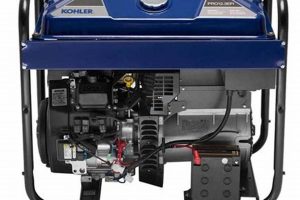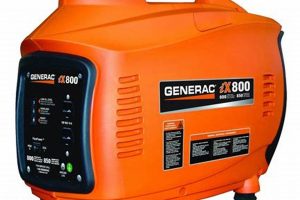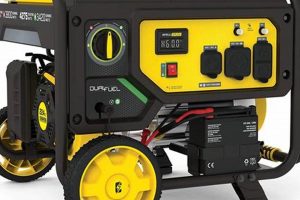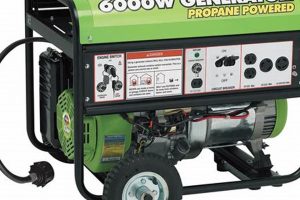A compact, fuel-powered device capable of producing electricity on demand, typically utilizing liquefied petroleum gas (LPG) as an energy source. These devices offer independent power generation suitable for various applications, from recreational activities like camping and tailgating to emergency backup power for homes and businesses. A typical example would be a unit enclosed in a protective frame, featuring an engine, alternator, fuel tank, and electrical outlets.
Independent power generation offers significant advantages in situations where grid electricity is unavailable or unreliable. This capability is invaluable during power outages caused by severe weather, grid failures, or remote location limitations. The relative portability of these units allows for easy transport and deployment where needed, unlike larger, stationary generators. Furthermore, the use of propane offers a relatively clean-burning fuel source compared to gasoline-powered alternatives. Historically, the demand for such independent power solutions has grown alongside increasing societal reliance on electricity and the recognition of potential disruptions to that supply.
This article will delve into various aspects of these independent power sources, including their operation, maintenance, safety considerations, and selection criteria for different needs.
Operational and Safety Tips for Independent Power Generation
Proper operation and adherence to safety guidelines are paramount for maximizing the effectiveness and lifespan of independent power sources while mitigating potential hazards.
Tip 1: Ventilation is Key: Operate units exclusively in well-ventilated areas to prevent the accumulation of carbon monoxide, a colorless, odorless, and potentially lethal gas. Never operate indoors, including garages, even with doors or windows open. Adequate airflow is crucial for safe operation.
Tip 2: Fuel Handling Precautions: Exercise caution when handling propane tanks. Check for leaks using soapy water and inspect connections for tightness. Store propane tanks upright in a cool, dry, well-ventilated area away from flammable materials and ignition sources.
Tip 3: Grounding for Safety: Proper grounding is essential to prevent electrical shock. Follow manufacturer instructions for grounding procedures and ensure the unit is connected to a suitable grounding rod or system.
Tip 4: Regular Maintenance: Adhere to the manufacturer’s recommended maintenance schedule. This typically includes oil changes, air filter cleaning or replacement, and spark plug inspection. Regular maintenance ensures optimal performance and longevity.
Tip 5: Load Management: Avoid overloading the unit. Calculate the total wattage of devices to be connected and ensure it does not exceed the generator’s rated output. Overloading can damage the unit and create safety hazards.
Tip 6: Proper Storage: When not in use, store units in a dry, protected location. Ensure the fuel tank is empty or properly stabilized for long-term storage to prevent fuel degradation and potential starting issues.
Tip 7: Carbon Monoxide Detectors: Install carbon monoxide detectors in any area where individuals may be present near operating units. These detectors provide an early warning of potentially hazardous carbon monoxide buildup.
Implementing these precautions enhances operational safety, prolongs equipment lifespan, and ensures reliable power generation when needed. Careful planning and adherence to safety protocols are critical for successful independent power generation.
By understanding the operational and safety aspects, users can effectively utilize independent power sources while mitigating potential risks. This concludes the discussion on practical tips and safety measures.
1. Power Output
Power output represents a critical specification for portable propane generators, directly influencing the range of applications and the types of devices it can power. Understanding power output is essential for selecting a generator that effectively meets specific power demands.
- Rated Power (Running Watts)
Rated power, often referred to as running watts, denotes the continuous power output a generator can sustain for extended periods. This figure is crucial for powering essential appliances and devices during outages or in off-grid situations. For example, a generator with a rated power of 3000 watts could reliably operate a refrigerator, several lights, and a small fan simultaneously. Overloading beyond the rated wattage can lead to generator damage and potential safety hazards.
- Surge Power (Starting Watts)
Surge power, also known as starting watts, signifies the maximum power output a generator can briefly deliver to accommodate the initial surge of power required by certain appliances, particularly those with electric motors. Items like refrigerators, air conditioners, and power tools often require a higher surge wattage than their running wattage. A generator’s surge capacity should be considered when selecting a unit to power devices with high starting power requirements. For example, a refrigerator might require 1500 surge watts to start but only 700 running watts for continuous operation.
- Power Output Measurement
Power output is typically measured in watts (W) or kilowatts (kW). Manufacturers provide these specifications in the generator’s documentation. Understanding the power requirements of intended devices is crucial for selecting a generator with adequate capacity. Online calculators and resources can assist in determining total wattage needs. This accurate assessment ensures appropriate generator selection for specific application demands.
- Impact on Generator Size and Cost
Power output significantly influences a generator’s physical size, weight, and cost. Higher power output units generally necessitate larger engines, resulting in increased size and weight, along with a higher price point. Balancing power needs with portability and budget constraints is essential for informed generator selection. Consider factors like frequency of use, types of devices to be powered, and budget limitations when selecting a suitable power output range.
Careful consideration of these facets of power output is essential for selecting a portable propane generator that effectively and safely meets specific power requirements, whether for emergency backup power, recreational activities, or professional use. Matching power output to anticipated loads ensures optimal performance and prevents potential damage to both the generator and connected devices.
2. Fuel Efficiency
Fuel efficiency represents a critical factor in the operational cost and practicality of portable propane generators. A more fuel-efficient generator reduces operating expenses and extends runtime on a given fuel supply, crucial for extended outages or remote applications. Understanding the factors influencing fuel efficiency enables informed decisions and optimal generator usage.
- Run Time and Tank Size
The relationship between fuel tank size and generator runtime directly impacts fuel efficiency considerations. Larger tanks offer extended operation but increase the unit’s overall size and weight. Conversely, smaller tanks enhance portability but necessitate more frequent refueling. Balancing runtime needs with portability requirements is essential for selecting an appropriately sized fuel tank. Manufacturers typically provide runtime estimates at various load levels, enabling users to estimate operational duration based on anticipated power demands.
- Load Size and Fuel Consumption
The load placed on a generator directly correlates with fuel consumption. Operating the generator at higher loads consumes fuel more rapidly than lighter loads. Understanding the power requirements of connected devices helps optimize fuel consumption. Operating the generator at the lowest load necessary to power essential devices extends runtime and maximizes fuel efficiency. Avoiding unnecessary power consumption by disconnecting non-essential devices contributes to efficient fuel utilization.
- Engine Efficiency and Technology
Engine design and technology significantly influence a generator’s fuel efficiency. Advanced engine technologies, such as inverter generators, adjust engine speed according to power demand, resulting in improved fuel economy compared to traditional fixed-speed generators. Inverter generators offer enhanced fuel efficiency, particularly at lower loads, making them suitable for applications requiring extended runtimes. Researching engine specifications and technologies provides insights into potential fuel efficiency gains.
- Maintenance and Fuel Efficiency
Regular maintenance plays a crucial role in maintaining optimal fuel efficiency. Routine maintenance tasks, such as air filter cleaning or replacement, spark plug inspection, and carburetor adjustments, contribute to efficient engine operation. Neglecting maintenance can lead to increased fuel consumption and reduced engine performance. Adhering to the manufacturer’s recommended maintenance schedule ensures long-term fuel efficiency and optimal generator performance.
Understanding these interconnected factors empowers users to make informed decisions regarding generator selection and operation. Optimizing fuel efficiency minimizes operational costs, extends runtime, and reduces environmental impact. Careful consideration of these factors contributes to a more sustainable and cost-effective approach to portable power generation.
3. Portability
Portability represents a defining characteristic of these generators, directly influencing their usability and suitability for various applications. The portability of a unit derives from factors such as size, weight, and integrated features designed to facilitate transport. Compact dimensions and manageable weight enable convenient movement and deployment in diverse locations, from campsites and tailgates to disaster relief sites and remote work areas. Integrated handles, wheels, and compact frames contribute to ease of transport, enabling individuals to relocate the generator as needed. This portability contrasts sharply with larger, stationary generators, which require specialized equipment and expertise for relocation.
The practical significance of portability becomes evident in scenarios where power is required in locations inaccessible to grid electricity. Outdoor events, construction sites, and emergency situations benefit significantly from the ability to deploy power generation on demand. For instance, during a power outage, a portable unit can power essential household appliances, maintaining critical functions like refrigeration and lighting. Similarly, in remote locations lacking grid infrastructure, these generators provide power for tools, communication equipment, and other essential devices. The portability factor allows for rapid deployment and efficient power delivery precisely where and when needed.
However, portability considerations often involve trade-offs. Smaller, lighter units typically offer lower power output and shorter runtimes compared to larger, less portable counterparts. The balance between portability and power requirements necessitates careful consideration based on the intended application. Selecting a unit with appropriate portability features and power capacity ensures optimal functionality and ease of use in the intended environment. Understanding this balance is crucial for effectively utilizing portable power generation in diverse scenarios, from recreational activities to critical emergency response.
4. Runtime
Runtime, a crucial performance metric for portable propane generators, signifies the duration a unit can operate continuously on a single fuel tank. This duration directly impacts the generator’s practicality and suitability for various applications, ranging from recreational activities to emergency power supply. Understanding the factors influencing runtime is essential for effective generator selection and utilization.
- Fuel Tank Capacity
Fuel tank capacity directly correlates with potential runtime. Larger tanks hold more fuel, enabling longer operation before refueling. However, increased tank size often translates to increased generator size and weight, potentially impacting portability. Manufacturers typically specify tank capacity in gallons or liters. A larger tank is beneficial for extended power needs, while a smaller tank might suffice for shorter durations or where portability is paramount. For example, a 10-gallon tank generally provides a longer runtime than a 5-gallon tank, assuming similar fuel consumption rates.
- Load and Power Consumption
The load placed on the generator significantly influences runtime. Higher power demands consume fuel more rapidly, shortening the operational duration. Conversely, lighter loads extend runtime as fuel consumption decreases. Understanding the power requirements of intended devices allows for accurate runtime estimation. For instance, running a single lightbulb consumes less fuel and provides a longer runtime compared to powering multiple appliances simultaneously. Operating the generator at the minimum necessary load optimizes runtime and fuel efficiency.
- Engine Efficiency and Technology
Engine efficiency plays a critical role in determining runtime. More efficient engines extract more energy from the fuel, extending the operational duration on a given fuel volume. Inverter generators, known for their variable engine speed, often exhibit higher fuel efficiency, especially at lower loads, leading to extended runtimes compared to traditional fixed-speed models. Technological advancements in engine design contribute to improved fuel efficiency and longer operational durations.
- Environmental Factors
Environmental conditions, such as temperature and altitude, can subtly influence runtime. Extreme temperatures can impact engine performance and fuel efficiency. Similarly, higher altitudes may require engine adjustments for optimal operation, potentially affecting fuel consumption and runtime. While these factors might not drastically alter runtime in typical operating conditions, they can become relevant in extreme environments. Consulting the manufacturer’s guidelines for operation in specific environmental conditions ensures optimal performance and accurate runtime estimations.
These interconnected factors underscore the dynamic nature of runtime for portable propane generators. Careful consideration of these elements empowers informed decision-making regarding generator selection and operation, maximizing the unit’s utility and ensuring reliable power delivery for the desired duration. Balancing runtime requirements with other factors like portability, power output, and fuel efficiency is crucial for effective portable power generation.
5. Noise Levels
Noise levels represent a significant consideration when selecting and operating a portable propane generator. Excessive noise can disrupt activities, disturb neighbors, and create undesirable soundscapes. Understanding the factors contributing to generator noise and available mitigation strategies is crucial for responsible and considerate operation.
- Decibel Levels and Human Perception
Generator noise is typically measured in decibels (dB). A logarithmic scale quantifies sound intensity, with higher dB values indicating louder sounds. Human perception of loudness is subjective, but prolonged exposure to high dB levels can cause discomfort and potential hearing damage. Generators vary significantly in their noise output, ranging from quieter inverter models to louder conventional units. Manufacturers typically provide decibel ratings, allowing for comparisons and informed selection based on noise tolerance and environmental considerations. Understanding decibel levels is crucial for selecting a generator appropriate for specific environments and minimizing noise-related disturbances.
- Factors Affecting Noise Output
Several factors contribute to a generator’s noise output. Engine size and type, exhaust design, and overall construction influence noise levels. Larger engines generally produce more noise than smaller engines. Similarly, conventional generators with fixed engine speeds tend to be louder than inverter generators, which adjust engine speed according to power demand. The design of the exhaust system plays a critical role in mitigating noise. Mufflers and other noise-reducing components can significantly attenuate exhaust noise. The overall construction of the generator, including the housing and insulation, also impacts noise levels. Robust construction and effective insulation contribute to quieter operation.
- Noise Reduction Techniques and Strategies
Various techniques can effectively reduce generator noise. Positioning the generator on a sound-absorbing surface, such as a rubber mat or a thick piece of plywood, can dampen vibrations and minimize noise transmission. Constructing a sound barrier around the generator using materials like sound blankets or plywood enclosures further attenuates noise propagation. Maintaining adequate distance between the generator and populated areas also helps reduce noise impact. Furthermore, adhering to the manufacturer’s recommended maintenance schedule ensures optimal engine performance and minimizes unnecessary noise caused by mechanical issues. Implementing these strategies significantly reduces noise pollution and promotes considerate generator operation.
- Regulations and Considerations
Many communities and campsites have noise ordinances regulating generator operation. These regulations typically specify permissible decibel levels and allowable operating hours. Adhering to these regulations is crucial for responsible generator use and maintaining positive community relations. Researching local noise ordinances before operating a generator ensures compliance and avoids potential penalties. Furthermore, considerate generator operation demonstrates respect for neighbors and fellow campers, fostering a positive and peaceful environment. Prioritizing noise reduction strategies and adhering to local regulations promotes responsible generator usage and minimizes noise-related disturbances.
Careful consideration of noise levels contributes to responsible generator selection and operation. Balancing power needs with noise considerations ensures both functionality and environmental harmony. Prioritizing quieter operation enhances the overall experience and promotes positive community relations.
6. Safety Features
Safety features represent critical components of portable propane generators, designed to mitigate potential hazards associated with fuel combustion and electricity generation. These features play a crucial role in protecting users, equipment, and surrounding environments. A comprehensive understanding of these safety mechanisms is essential for safe and responsible generator operation.
Several key safety features contribute to the safe operation of portable propane generators. Automatic shutoff valves interrupt fuel supply in the event of low oil pressure or overheating, preventing engine damage and potential fire hazards. Overload protection circuits prevent damage to the generator and connected devices by automatically shutting down the unit when electrical loads exceed its capacity. Spark arrestors, integrated into the exhaust system, trap sparks generated during combustion, reducing the risk of fire, especially in dry or flammable environments. Properly grounded units prevent electrical shock hazards by providing a safe path for stray currents. These integrated safety mechanisms work in concert to minimize potential risks associated with generator operation.
Real-life examples illustrate the practical significance of these safety features. An automatic shutoff valve can prevent catastrophic engine failure by stopping the engine before it seizes due to low oil. Overload protection safeguards sensitive electronic devices connected to the generator from power surges. Spark arrestors prevent wildfires ignited by stray sparks from the exhaust, particularly in dry vegetation areas. These examples underscore the critical role safety features play in mitigating potentially hazardous situations. Understanding and relying on these features promotes responsible generator use and enhances overall safety.
The absence or malfunction of these safety features can have serious consequences. Operating a generator without a functional automatic shutoff valve risks irreversible engine damage due to low oil or overheating. Overloading a generator without overload protection can damage both the generator and connected devices, leading to costly repairs or replacements. The absence of a spark arrestor increases the risk of fire, particularly in areas with dry vegetation or flammable materials. Regular inspection and maintenance of these safety features are paramount for ensuring their proper function and mitigating potential hazards.
In summary, safety features are integral components of portable propane generators, playing a crucial role in preventing accidents and protecting users and equipment. Understanding and maintaining these features is essential for responsible and safe generator operation. Regular inspection and adherence to manufacturer guidelines ensure the continued effectiveness of these safety mechanisms and contribute to a safe operating environment.
Frequently Asked Questions
This section addresses common inquiries regarding the selection, operation, and maintenance of portable propane generators.
Question 1: How is the appropriate size generator determined for specific needs?
Determining the correct generator size requires calculating the total wattage of devices intended for simultaneous operation. Consider both running watts (continuous power) and surge watts (starting power) for each device. Online wattage calculators and consultation with electricians can assist in accurate load assessment.
Question 2: What are the key safety precautions when operating a unit?
Operate generators exclusively outdoors in well-ventilated areas to prevent carbon monoxide poisoning. Proper grounding is essential to prevent electrical shock. Exercise caution when handling propane fuel, ensuring proper connection and leak checks. Never refuel a hot generator.
Question 3: How frequently should maintenance be performed?
Adhere to the manufacturer’s recommended maintenance schedule. This typically includes regular oil changes, air filter cleaning or replacement, and spark plug inspection. Regular maintenance ensures optimal performance, fuel efficiency, and longevity.
Question 4: What type of oil is recommended for these generators?
Consult the owner’s manual for the manufacturer’s specific oil recommendations. Using the incorrect oil type can damage the engine and void warranties. Generally, small engine oils formulated for air-cooled four-stroke engines are suitable.
Question 5: Can these generators be used in parallel to increase power output?
Some models offer parallel capability, allowing two units to be connected for increased power output. However, not all generators are designed for parallel operation. Consult the owner’s manual to determine if parallel operation is supported and follow manufacturer instructions carefully.
Question 6: What are the long-term storage recommendations?
For long-term storage, drain the fuel tank completely or add a fuel stabilizer to prevent fuel degradation. Store the generator in a dry, protected location. Disconnect the battery or maintain it according to manufacturer recommendations.
Understanding these key aspects contributes to informed decisions and safe generator operation. Prioritizing safety and adherence to manufacturer guidelines ensures reliable and efficient portable power generation.
This concludes the frequently asked questions section. The next section will discuss…
Conclusion
Portable propane generators offer a versatile solution for independent power generation in various contexts, from recreational activities to emergency preparedness. Careful consideration of factors such as power output, fuel efficiency, portability, runtime, noise levels, and safety features is crucial for selecting the appropriate unit for specific needs. Adherence to operational guidelines and regular maintenance ensures safe, reliable, and efficient performance. Understanding the capabilities and limitations of these devices empowers users to effectively harness the benefits of portable power generation.
As technology continues to advance, further enhancements in fuel efficiency, noise reduction, and safety features are anticipated. Responsible use and adherence to safety protocols remain paramount for maximizing the benefits and minimizing the risks associated with these valuable power solutions. Informed decision-making and proactive maintenance practices ensure the continued utility and longevity of portable propane generators, contributing to enhanced preparedness and resilience in diverse scenarios.






